May 4, 2013
Linagpang Nga Turagsoy
Jan 22, 2007
Sinigang na Sugpo (Prawns in Sour Soup)

On our way back from Baguio on New Year's Eve we passed by a series of street vendors selling tiger prawns along the highway at Sison, Pangasinan. The prawns were really huge -- an outstretched piece measured 6 inches on the average. We stopped to ask and lo, a surprise -- we were told the prawns sell for only P450 a kilo! (Back in Manila Mike bought much smaller ones for P550 per kilo, so we actually exchanged surprised, incredulous glances when we heard the price!) My husband hastily bought two kilos, and I dreamed of making Prawns Thermidor for media noche.
When we got home many hours after we weighed the prawns in and found to our dismay that the pack was short of 500g or so. Talk about disappointment. Filipinos cheating fellows. Shame.
Mental note to self: Bring your own weighing scale the next time.
Anyhow, I was too tired and low bat (and much too much in a rush) that I didn't get to make Prawns Thermidor that night. I cooked half the bunch into Chili Butter Shrimp instead. Of course, if and when I get to make Prawns Thermidor, you'd see the recipe here.
The prawns you see up there were bought and cooked many months ago (on Easter Sunday in fact, the next one but a few months away). Ang layo ba ng segue? Hehehe. Sowee!
Sinigang na Sugpo (Prawns in Sour Soup)
What's In It?
500g. prawns or shrimp
6 to 8 cups rice washing or tap water
1 bunch sitao (string beans), cut into 2" lengths
1 to 2 pieces labanos (radish), peeled and sliced into half-inch wedges
2 bunches kangkong (swamp cabbage), leaves separated from stalks, washed
2 red onions, peeled and quartered
2 large ripe tomatoes, washed and quartered
1 knob ginger, peeled and sliced into rings
2 pcs green peppers (optional)
juice of 6 to 8 calamansi (Philippine lemon) or 1 sachet Knorr Sinigang sa Calamansi
1 1/2 t iodized salt or 1 T fish sauce
Kitchen Conjugations:
In a saucepan combine the ricewashing/water, onions, tomatoes, ginger and green pepper then heat to a rolling boil. Add in shrimps/prawns, radish and string bean slices and let boil for another two minutes or until the radish becomes translucent. Season with the salt/fish sauce, calamansi juice and simmer for 30 seconds, then add in kangkong leaves. Let simmer for 30 seconds or so, enough to blanch the leaves.
Serve while hot.
Dec 1, 2006
Sinigang na Bangus with Tanglad
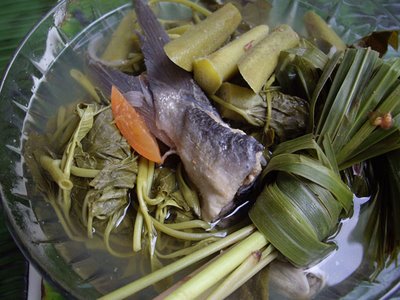
Rainy and windy (albeit stormy) weather is always good for one thing -- hot broths. Bulalo would have been nice, but my, the cholesterol! So we opted for Sinigang na Bangus.
As in all broths and stocks, the best flavor comes from the bony parts -- the bone marrow makes bulalo savory, the buto-buto or ribs makes Sinigang na Baboy flavorful. For fish sinigang, well, I believe the head and the tail are the best parts. (Reserve the belly for frying. Make it crisp and wow -- you've got the best combination!)
Anyhow, I discovered SeaKing's Bangus head and tails pack in Shopwise. The pack, which costs P30.00 max, is all head and tails, 500 grams. Throw in some veggies and you have soup for 8! Great, di ba? The tanglad was thrown in for flavor, but go ahead without it and you'd be okay. :)
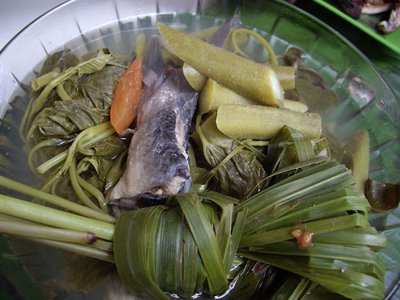
SINIGANG NA BANGUS WITH TANGLAD
What's In It?
500 g. Bangus, head and tails
1 teaspoon salt
1 large red onion, peeled and quartered
1 large or 2 medium ripe tomatoes, quartered
1 knob ginger, peeled and sliced diagonally
juice of 8 calamansi or 1 pack Knorr Sinigang sa Calamansi mix
1 bunch tanglad (lemongrass), about 8 stalks
8 to 10 cups rice washing, or tap water
2 bunches kangkong, leaves separated from stalks
1 bundle okra, sliced diagonally into 2" pieces
2 teaspoons salt or fish sauce
Kitchen Conjugations:
Wash head and tails and season with 1 teaspoon salt. Set aside.
In a saucepan, boil water/rice washings with the onions, ginger, tomatoes and tanglad. Add in okra and fish when water comes to a rolling boil. Simmer for 2 minutes then season with calamansi and salt or fish sauce. Simmer for another 2 minutes, then add in kangkong. Leave to boil for another minute then remove from heat. Adjust seasonings if necessary, then serve.
Tanglad is usually removed before serving, but I always leave it in for drama. :)
Oct 1, 2006
Maize Picadillo
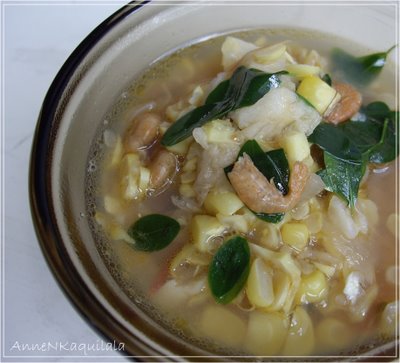
To me this is Maize Picadillo; to some, it's made with chicken and ampalaya (bittergourd) leaves and called Suam na Mais. This version uses malunggay, is made flavorful by fresh shrimps, and has a clear broth. I learned the recipe from watching my lola who used to cook it for Saturday lunch when it's corn season. Back then she used white young corn; my version uses the sweet corn I prefer.
My lola was home from New Zealand last month and this was among the dishes I lined up for her enjoyment (to match the fried tilapia I knew she missed so badly).
 Maize Picadillo/Ginisang Mais
Maize Picadillo/Ginisang MaisWhat's In It?
- 6 sweet corn cobs
- 100 g. pork, diced
- 50 g. small shrimps
- 1 med. onion, peeled and sliced
- 5 cloves garlic, peeled and minced
- 1 medium-sized ripe tomato, sliced
- 1 c malunggay leaves
- 3 T cooking oil
- 3 to 4 T fish sauce
- 6 cups tap water or pork broth
Kitchen Conjugations:
Wash corn and remove hair. Using a serrated kitchen knife, scrape off the kernels from the cobs to make about 4 to 5 cups. Set aside.
Heat cooking oil in a wok or carajay over medium heat. Saute onions, tomato slices and garlic. Add in pork and stir fry for one minute or until pork loses its pinkish tint. Stir in shrimps and corn kernels then stir fry for half a minute. Stir in fish sauce, cover, turn down heat and let simmer for about a minute and 30 seconds, to allow ingredients to sweat.
Pour in water or pork broth and let boil for 10 minutes or until the kernels are tender. Adjust seasonings, then stir in malunggay leaves. Allow to boil for half a minute to blanch malunggay. Remove from heat and serve immediately.
Best with crispy fried tilapia, daing na bangus, or fried galunggong. :)
Aug 8, 2006
Shanghai Noodle Soup
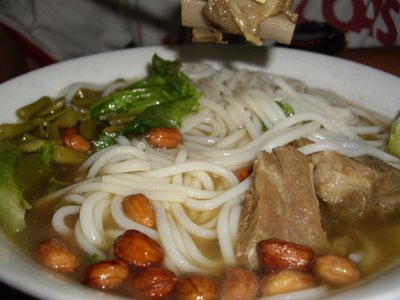
For 3 days and 4 nights in Shanghai Mike and I were deaf-mute adventurers. Deaf-mutes because we can't understand or speak Chinese beyond the Suh (Yes), Poh (No), Shishi (Thank you") and Po Yung Shi (You're Welcome) that I learned from the meeting with our supplier; adventurers because we shied away from the big and better known restaurants and went out to the side streets of Nanjing to try quaint noodlehouses.
(Un)fortunately there was a dearth of English speakers among the waiters and shop owners; and only one shop had an English menu. I had to stand by the counter and look out at the trays the servers carried, pointing to the dishes that looked good, gesturing that I wanted to order them. (Can you picture how funny that was?)
In the end, since they were mostly noodle houses, we ended up eating a different kind of noodle soup each day. One of them is the dish pictured above. :)
Noodle-mania rubbed on us, so we were still hung up on Shanghai cuisine and had noodle soup the night following our return.
 For this I just put together pre-soaked rice noodles, some siomai, bok choy, chayote, strips of smoked squid, a swig of light soy sauce and a dash of sesame oil.
For this I just put together pre-soaked rice noodles, some siomai, bok choy, chayote, strips of smoked squid, a swig of light soy sauce and a dash of sesame oil.
Jun 26, 2006
Tom Yum Thalay (Thai Hot and Sour Seafood Soup)
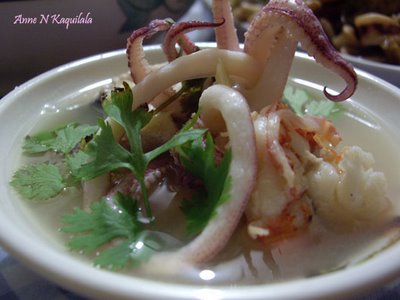 We had originally wanted soup because it's a rainy evening, but since we haven't gone Thai for quite a while and I have a handful of coriander leaves (wansoy) in the ref the idea of Tom Yum hit. It would have been simply Tom Yum Goong (prawn soup) but my husband wanted his tanigue chunks in, so I decided to go the whole nine yards and do the seafood version. As the picture shows I put in some squid too. Oh yes, we have the whole ocean in our freezer. The story of that, later, in another post. Kung hindi ako tatamarin. :P
We had originally wanted soup because it's a rainy evening, but since we haven't gone Thai for quite a while and I have a handful of coriander leaves (wansoy) in the ref the idea of Tom Yum hit. It would have been simply Tom Yum Goong (prawn soup) but my husband wanted his tanigue chunks in, so I decided to go the whole nine yards and do the seafood version. As the picture shows I put in some squid too. Oh yes, we have the whole ocean in our freezer. The story of that, later, in another post. Kung hindi ako tatamarin. :PAnd of course it helped that I have three thriving pots of lemon grass in my garden. I can't say it enough -- the unknowing would have found it weird and funny that this house grows GRASS in pots. Hehehe. The maid waters them everyday too! :P
TOM YUM THALAY
What's in it?
- 8 medium sized prawns, shells peeled but tails left intact, and deveined
- 2 large squid, ink sacs removed, body cut into rings
- 150 grams fish nuggets
- 4-6 cups rice washings or tap water
- 5 stalks fresh lemongrass, lightly pounded, cut into 1" pieces
- 4 T fish sauce
- 3 knobs ginger, peeled and pounded
- 1 large red onion, quartered
- 1/2 cup straw mushroom
- 4 tablespoons lime juice
- 6 crushed chili peppers
- wansoy leaves for garnish
Kitchen Conjugations:
In a pot combine rice washing, lemongrass, ginger, red onion and bring to a boil. Add mushrooms, fish sauce and lime juice, let boil for two minutes.
Add in prawns, fish, squid and chile peppers. Let boil for a minute then remove from heat. Adjust seasonings, and garnish with the coriander/wansoy leaves. Serve hot.
Some notes:
1) The real recipe for Tom Yum called for:
- Galangal, a better, more aromatic relative of ginger.
- Kaffir lime leaves, used with regularity in a wide array of favorite Thai dishes for its unique luscious perfume and striking flavor
- Prik Pao, chili paste with soya bean oil. It's made up of sugar, shallots, soyabean oil, garlic, dried chili, fish sauce, dried shrimp and tamarind paste. This gives the soup its characteristic red color.
I didn't have these three so I improvised, substituting with ginger for galangal; adding a little calamansi for the lime; and doing without the color from the Prik Pao.
2) Alternatively, if you are in a hurry or simply want to simplify things, you may want to try the various mixes and pastes available in supermarkets. Some brands I have tried (with satisfactory results) is the Lobo brand (with Thai markings), about P36.00; and Kim's (I forgot how much, but less).
Apr 1, 2006
Sinigang na Ulo
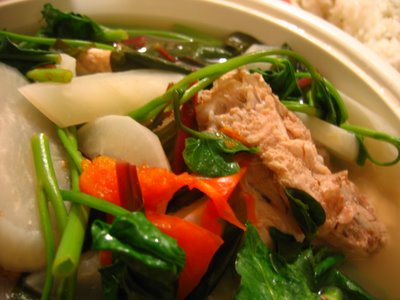 Anyhow, to celebrate that little rain and the unexpected reprieve from the summer heat, I decided to make broth that night. Nothing's heartier than soup when it's a rainy night.
Anyhow, to celebrate that little rain and the unexpected reprieve from the summer heat, I decided to make broth that night. Nothing's heartier than soup when it's a rainy night.Also, since the soup is hearty, we have a reason to skip rice. (Yehey!) Also, since Mike and I made a quick stopover at his suki at the palengke in Pacita and he bought a truckload of fish again, including the whole head of a maya-maya, I made Sinigang na Ulo.
I really don't think you need the recipe, but if you do, here it is. :)
Sinigang na Ulo
(Fish Head Sour Soup)
What's In It?
1 big head of Maya-maya (Snapper), about 1kg, cleaned and chopped
1 large onion, peeled and quartered
2 large native tomatoes, quartered
2 bundles kangkong (swamp cabbage), washed, leaves separated from stalks
1 large radish, peeled and sliced
juice from 5-7 pieces calamansi (Philippine lemon)
3-5 tablespoons patis (fish sauce); or to taste
1 liter water or rice washing
Kitchen Conjugations
In a large pot, boil the water/rice washing with the quartered onions and tomatoes. When the water gets to a rolling boil, add in the fish head and the radish and allow to boil until the radish is half-cooked (semi-translucent). Pour in patis and calamansi juice and boil until the radish is cooked. Check seasonings. Add in kangkong, allow to boil for 30 seconds (or to crisp-tenderness) then remove pot from heat.
PS
1. Use the water from the second time of washing rice grains if you opt to use rice washing. The soup gets more flavorful (malinamnam).
2. You can use tamarind instead of calamansi, but for fish soups I always use calamansi to remove the fishy-ness (lansa).
3. You can also use Knorr Sinigang sa Calamansi. If you opt to, make sure to pour in the mix long before you add the fish and other ingredients, to make sure that you cook the artificial ingredients in the mix long enough without overcooking the fish and/or veggies.


